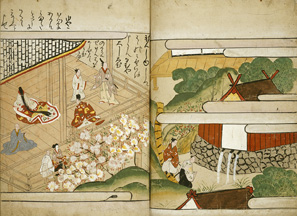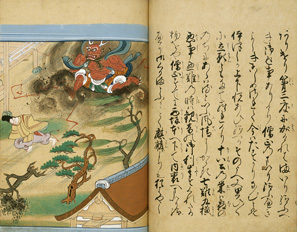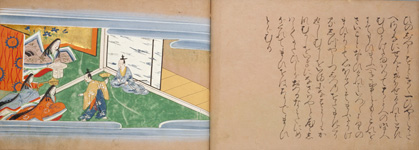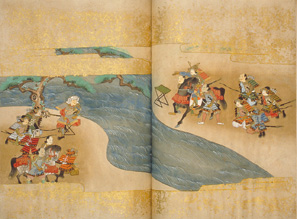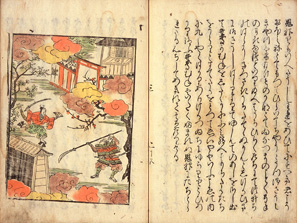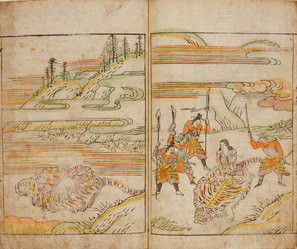This is a nara-ehon of the Noh song, "Yuya." "Yuya" is the name of the heroine.
Home > 3. Variety of "ehon" books > Nara-ehon and Tanroku-bon
61. Yuya
- copied in the Keicho Era (1596 to 1615), 1 book, 30.9
 22.9cm <WA32-19>
22.9cm <WA32-19>
62. Tenjin ki
- 3 volumes, copied in the Keicho Era (1596 to 1615), 3 books, 33.8
 25.0cm <WA32-20>
25.0cm <WA32-20>
This is a large nara-ehon that depicts the life of Sugawara Michizane (845 to 903), a famous politician and literary man.
63. Kosode Soga
- copied in the Kanbun and Enpo Eras (1661 to 1681), 1 book, 17.4
 25.4cm <WA32-18>
25.4cm <WA32-18>
This rectangular-shaped nara-ehon depicts a story of Soga brothers, Juro and Goro, to revenge their murdered father.
64. Koyo gunkan
- 35 volumes, copied in the Kanbun and Enpo Eras (1661 to 1681), 35 books, 29.0
 22.0cm <WA32-1>
22.0cm <WA32-1>
This vividly colored nara-ehon depicts the war battles for two generations: Takeda Shingen (1521 to 1573) and his son, Takeda Katsuyori (1546 to 1582), military commanders of Kai Province.
65. Gikei ki
- 8 volumes, printed around Genna and Kan'ei Eras (1615 to 1644), 8 books, 27.5
 19.5cm <WA7-266>
19.5cm <WA7-266>
Old movable-type edition. Gikei ki depicts the life story of Minamoto Yoshitsune, a famous military commander. The exhibit is the first printed book of Gikei ki with illustrations inserted. Pictures are colored with brushes.
66. Kumano no honji
- 3 volumes, printed around the late Kan'ei Era to the Shoho Era (1633 to 1648), 3 books, 27.4
 17.8cm <WB2-9>
17.8cm <WB2-9>
This is a religious narrative in which the royal family of ancient India came to Japan and became the gods in Kumano. This tanroku-bon is colored in red, green, yellow and purple. The same version is also possessed by the New York Public Library.
67. Taikenmon Heiji kassen
- 2 volumes, Soshiya Kyubee (of Kyoto), printed in the 20th year of the Kan'ei Era (1643), 1 book, 18.7
 12.8cm <
12.8cm < 328>
328>
This illustrated tanroku-bon records the verses of ko-joruri (an old ballad drama in the 17th century that is told melodiously to the accompaniment of a Japanese guitar called shamisen). This is a story of Minamoto Yoshitomo, a military commander, and his follower, Kamata Masakiyo, who meet their ends. The illustrations are simply colored in vermillion and green.


